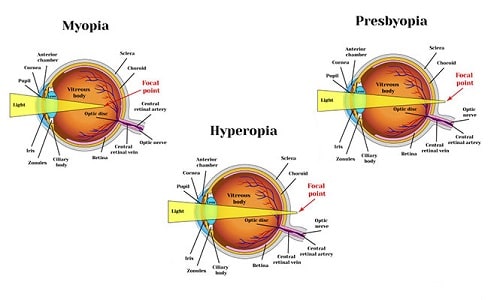If you’re farsighted, you can see things far away, but you have problems seeing close up. This condition is also known as hyperopia. It’s a common vision problem, so if you’re dealing with it, you’re far from alone. In fact, it’s estimated that 10 percent of the population of the United States has the condition.
Here’s some information on the causes of farsightedness, ways to tell if you have hyperopia, and some of the methods used to correct the problem.

What Causes Farsightedness?
People who are farsighted have what is known as a “refractive error” affecting their eyes. This is the reason why you can see objects at long distances better than objects that are nearer to you. When you’re able to better see objects close to you, that is myopia.
Refraction is the term given to the way light rays are bent as they pass through one thing to another thing. When it comes to vision, it refers to the way light rays bend as they go through your cornea and hit the lens of your eye.
The rays then hit your retina, which converts them into messages that pass to your brain through the optic nerve. What you “see” is the result of your brain interpreting those messages.
When you have a refractive error, your eye isn’t able to focus light on your retina correctly.
There are a few different reasons why this happens. In some farsighted people, the shape of their eye is the culprit. In other cases, the shape of the cornea has changed. The reason could also be that the lens has deteriorated with age.
Both children and adults can be farsighted. If your parents are farsighted, there’s a good chance you will be as well.
Symptoms of Farsightedness
The symptoms of farsightedness differ for different people. One of the more common signs, however, is squinting when trying to see something up close. Other symptoms of farsightedness include blurred vision, eye strain and achy eyes, and headaches. You might also notice that your eyes ache or burn after you perform close-up work, such as reading. If you have to hold a book at arm’s distance to be able to read it, that’s another indication you’re probably farsighted.
Hyperopia vs. Presbyopia
There is another condition called presbyopia that is somewhat similar to hyperopia. As with farsightedness, someone with presbyopia can see objects at long distances, but they have a hard time focusing on closer objects. The difference is that while hyperopia is typically due to an issue with the shape of your eye, presbyopia occurs when your eye’s lens loses its flexibility because of age.
Diagnosing the Problem
If you have any reason to believe you might be dealing with farsightedness, your first step is to schedule a visit with an eye doctor. They’ll perform a thorough exam to determine the nature of your problem.
What kinds of exams can you expect? One exam is known as a refraction test. This is usually performed to determine what kind of prescription you need for corrective lenses. Some doctors will also perform a retinal exam. This includes the use of eye drops to dilate your pupils. The doctor then uses a special instrument, known as an ophthalmoscope, to examine the inside of your eye.
Addressing Farsightedness
Fortunately, farsightedness can be corrected in several ways. The three main options are glasses, contact lenses, and surgery. Let’s take a look at each one.
Glasses
Glasses are the easiest method of correcting hyperopia. And there are several different types of lenses. Some people only need single vision glasses, or “readers,” to see things close up. Others may opt for bifocals or trifocals. These provide not only sharper vision for long distances, but also for close-up work.
Progressive multifocal lenses provide the same benefits, but they look like single vision lenses. They’re often called “no line” bifocals.
Contact Lenses
Contact lenses are small lenses that go directly on your eye. They come in many different designs and are made of several different materials. Some of them are soft, while others are rigid. Just like eyeglasses, contacts come in both single vision and multifocal varieties. They often take a lot of care, however, so talk to your eye doctor about the pros and cons before you decide what type of contact lens is best for you.
Surgery
Three main types of surgery are used to correct hyperopia – LASIK, LASEK, and PRK.
-
LASIK
LASIK is short for “laser-assisted in situ keratomileusis.” In this procedure, the doctor first makes a thin incision into your cornea and adjusts it, using a laser, to correct farsightedness. It usually takes from three to six months for your vision to completely stabilize after LASIK surgery.
-
LASEK
This stands for “laser-assisted subepithelial keratectomy.” This involves a very thin incision in the outer covering of your cornea, known as the epithelium. Similar to LASIK, LASEK involves the use of a laser to reshape your cornea. After this is done, the doctor replaces the epithelium. Recovery time can vary from several weeks to several months.
-
PRK
PRK, or “photorefractive keratectomy,” is very similar to LASEK. The only difference is that the doctor does not replace your epithelium. This protective covering grows back naturally and conforms to the new shape of your cornea. Recovery typically takes between six weeks and six months following the procedure.
Are You Farsighted?
If you’re farsighted, you might notice that you’re squinting more than normal, or you feel more fatigued than usual after reading or looking at small print. If that’s the case, you might need to visit an eye doctor. Even though hyperopia can be a frustrating problem, it can be easily addressed through corrective lenses or a surgical procedure.
Sources:
For more information regarding your benefits, special offers, and eye care information feel free to contact us ![]()
![]() or
or